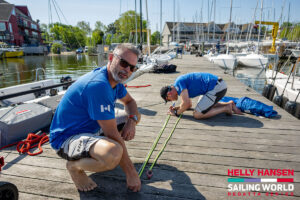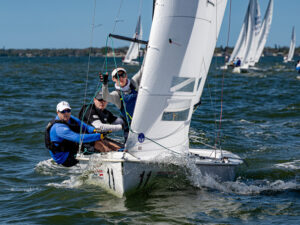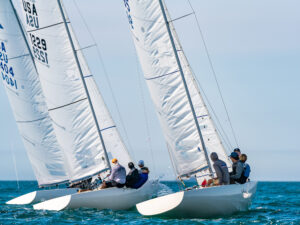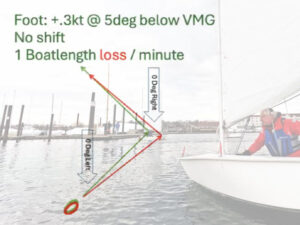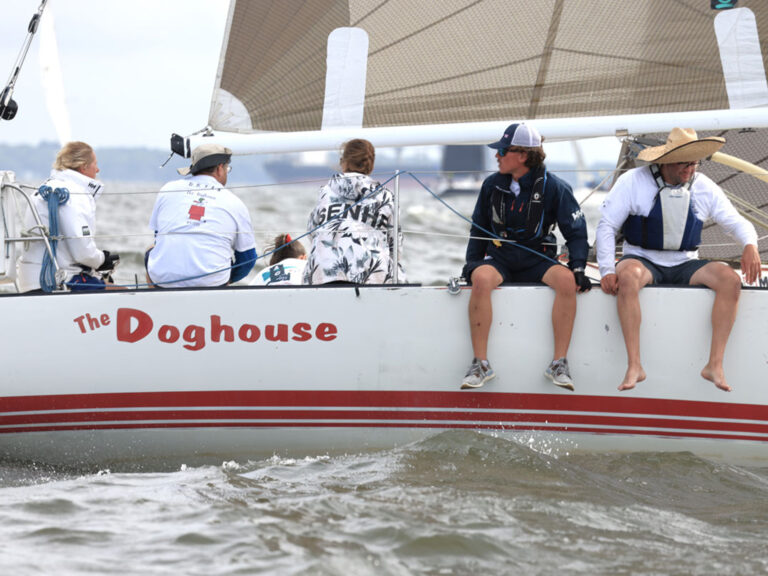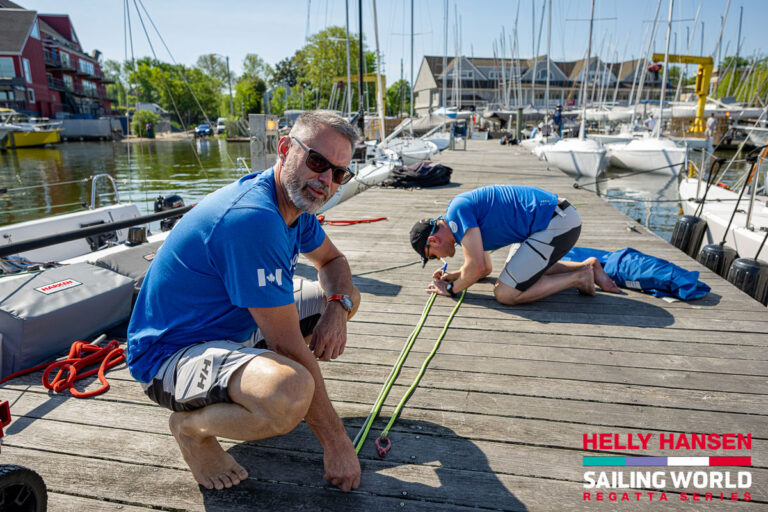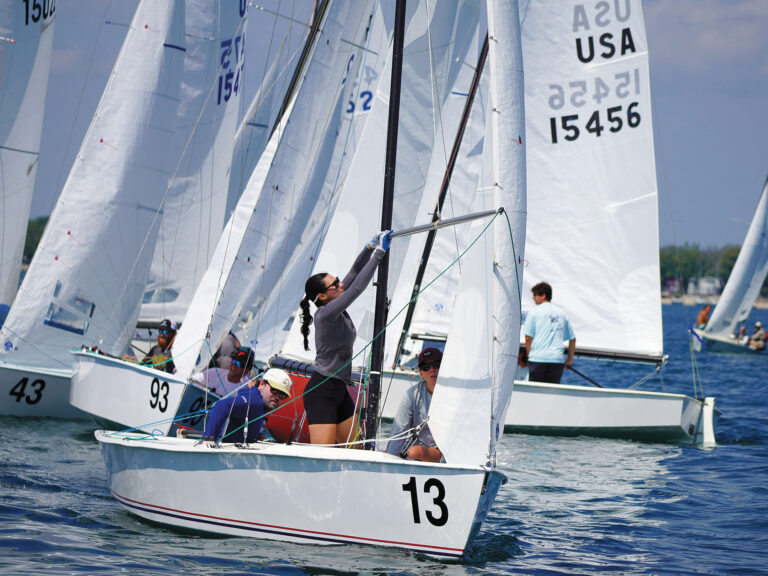
Rules: Gambling at Starting Marks
Suppose you’re on your final approach to the starting line, reaching on starboard tack toward the committee boat that serves as the starting mark at the starboard end of the line. A boat to leeward of you is overlapped with you on a parallel course and slightly bow-out on you. You know you’re barging and that you’re not entitled to room, but there’s an enticing gap between an outside boat and the stern of the committee boat. Should you gamble and sail into that gap?This month I will discuss four gambles of this sort that you might take as you approach a starting mark on your final approach to start. For each one, as I did in my previous column (“Gambling at Marks and Obstructions,” July/Aug. ’06), I’ll identify the rules that apply and the risks involved.The diagram on the top right shows the aforementioned barging situation. Rule 11 requires the windward boat, Harry, keep clear of the leeward boat, Bess, and he is doing so. Because the boats are approaching a starting mark to start, no part of Rule 18 applies (see Rule 18.1(a)). Because there is no proper course before the start, Rule 17 does not apply (see the definition Proper Course). The boats have been overlapped for some time, so Rule 15 does not apply either. If Bess were to change course, Rule 16.1 would require her to give Harry room to keep clear, and she would also have to comply with Rule 14 (Avoiding Contact). No other Part 2 rules apply.Should Harry continue into the gap between Bess and the stern of the committee boat? The answer depends on what Bess does. If she luffs up to a course which, if continued, would deprive Harry of room to pass between her and the committee boat, and if Harry is able, by luffing promptly and in a seamanlike manner, to leave the committee boat to port, then Harry is required to circle around and try to approach the line again later. However, if Bess delays her luff until Harry can no longer, by maneuvering promptly in a seamanlike way, leave the committee boat to port, then it is somewhat safer for Harry to sail into the gap between Bess and the mark.What should Harry do, if Bess hails, “You’re barging!” and begins to luff him into the committee boat? He should promptly try to comply with Rule 11 by keeping clear of Bess and, as he does so, hail her that he needs room to avoid hitting the committee boat. Bess must give Harry the space he needs to maneuver in the existing conditions in a seamanlike way to keep clear of her (see Rule 16.1 and the definition Room). It is certainly not “seamanlike” to hit the committee boat. Therefore, once Harry can no longer luff out of the gap between Bess and the committee boat’s stern, she must not deprive him of space to avoid the committee boat in a seamanlike way. In addition, Rule 14 requires her to avoid contact with him if reasonably possible.To sum up, if a leeward boat’s projected course would enable the windward boat to sail into the gap, keep clear, and avoid hitting the mark, then it’s safe for the windward boat to sail into the enticing gap. If the leeward boat does not want the windward to sail into that gap, she must prevent the windward boat from doing so by luffing while the windward boat still has room to leave the mark to port.Now, take a look at the second diagram showing Eleanor, a leeward boat, and Franklin, a windward boat, on their approach to the starting line to start. This situation is subtly different from the first one, in that if Eleanor holds her course there will not be room for Franklin to avoid hitting the mark. In this case, Franklin should definitely not sail into the space between Eleanor and the committee boat’s stern. Here are the reasons: Franklin is required by Rule 11 to keep clear of Eleanor. If Eleanor holds her course, Rule 16.1 will never apply-that was the rule that saved Harry’s bacon in the first example. If Franklin sails between Eleanor and the mark, then there will come a moment at which he is no longer keeping clear of her. At that moment, Franklin breaks Rule 11. True, Eleanor will be required by Rule 14 to avoid contact with him if it’s reasonable possible to do so. However, even if she did hit him, this would not negate his having broken Rule 11, and, what’s more, she would not be penalized if the contact did not cause damage or injury.Now let’s truck on down to the pin end of the line. If the pin end of the starting line is upwind of the committee boat end, you might be tempted to try a port-tack start at the pin. If you see the fleet setting up so that there’s no way a starboard-tack boat could hit you if you crossed the line near the pin, then go for it. However, life is never so easy.In the third diagram, the line slightly favors the pin. Mamie is reaching down the line with the intention of turning up to closehauled right after the starting signal is made. Ike is approaching the line on a track that will take him just to leeward of the pin. He can see that, if Mamie holds her course, he will be able to hold his course and keep clear of her. Mamie, of course, will not want to hold her course after the starting signal. She will want to luff up to closehauled. If she does, Ike will not be able to keep clear of her. He must decide whether to tack away, duck, or cross on port?Rule 10, the port-starboard rule, requires Ike to keep clear of Mamie, and, if she changes course, Rule 16.1 will require her to give him room to keep clear. Therefore, you might think that it would be safe for Ike to continue on port across her bow. I don’t think so.Suppose he did and, after the gun, Mamie luffed up and Ike failed to keep clear. If Mamie protested, Ike would have trouble avoiding a disqualification. Here’s why: He would have to establish as fact that, if Mamie had held her course, he would have kept clear as he crossed her bow, and that her luff deprived him of room to keep clear. Since Mamie did not hold her course, it will be difficult to establish that the hypothetical positions the boats would have been in had she held her course would’ve resulted in him keeping clear. Rule 10 is so basic and port-starboard collisions can be so serious that the protest committee is not likely to let Ike off the hook. Ike could make the case that Mamie broke Rule 16.1 when she luffed, but if I were him, I wouldn’t take the gamble.The diagram above, showing Rosalind on starboard and Jimmy on port, differs slightly from the first in that Rosalind is already on a closehauled course as the boats approach and she will not have to luff to pass to windward of the mark. Jimmy is on a course that will allow him to keep clear of Rosalind as he crosses her. Should Jimmy cross on port, tack, or duck?If Jimmy is confident he can cross Rosalind if she holds her course, he should go for it. If Rosalind protests, the facts will be much easier to reconstruct. She will not tack to avoid him because of other starboard-tack boats on her hip. The question will be whether she needed to bear off to avoid him, and if that question arises, Jimmy is likely to find witnesses to help.E-mail for Dick Rose may be sent to rules@sailingworld.com.

